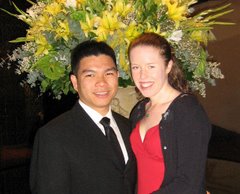Italian Sparkling Wines
 In honor of the Wine Club meeting tonight, I'm going to give my nod to Italian Sparkling Wines.
In honor of the Wine Club meeting tonight, I'm going to give my nod to Italian Sparkling Wines.
Every couple months or so, Jen and our good friend call together a meeting of the Wine Club which they both founded. The format is for each person to buy a bottle between $8-20, Jen would research the wines, and then she would report her findings while members do tastings over dinner. It's a great social affair as well as a fun way to learn about wine. I am not a member because, well, I don't really drink wine among other factors, but I do learn a lot from the Jen's research on wine.
For the Wine Club meeting tonight, our esteemed friend, Amit Shah, choose an Italian Red Sparkling Wine. What makes his wine interesting is that most people in America are used to French-style sparkling wines, and also, among the less common Italian sparkling wines, a red sparkling is even more rare. Furthermore, the red sparkling wine was a style highly regarded by European royality and that was one of the inspirations for why the winery choose to make this wine. What makes Italian sparkling different than the French variety is the Italian use of carbonation to make the bubbly part as opposed to French-style of bottle fermentation. They do not pump gas into the wine like carbonated soda but trap it by what is called the charmat method. The Italian also have grades of their bubbles, spumante and frizzante, meaning full sparkling and slightly sparkling, respectively. These grades are more easily created using the charmat method.
One of my all-time favorite wines to drink is Moscato d'Asti. It's a sweet semi-sparkling from Italy's Piedmont region. I would liken it to grape version of Orangina but with higher quality bubbles. Epicurious says of it to have "a mild level of sweetness balanced by vibrant acidity." We got a few bottles from our friend Rachel and her husband David a little while back. Whenever a bottle was opened and despite my lack of interest in wines, I'd drink the Moscato like it was water on a hot day without even knowing it.
Culinary Word of the Day: Charmat Method
A bulk method for making SPARKLING WINES developed around 1910 by Frenchman Eugène Charmat. The Charmat process involves faster and less expensive production techniques using large pressurized tanks throughout production. These interconnecting tanks retain the pressure (created by the production of CARBON DIOXIDE during FERMENTATION) throughout the entire process. For many winemakers, the Charmat process replaces the expensive MÉTHODE CHAMPENOISE technique of secondary fermentation in bottles, thereby enabling them to produce inexpensive sparkling wines. Charmat wines can be good (although, once poured, they often lose their bubbles quickly) but are usually not as esteemed as méthode champenoise sparkling wines. The Charmat process is superior, however, to the technique used by some producers of simply pumping carbon dioxide gas into STILL WINE (like carbonated soft drinks are made). The Charmat process is also called bulk process and in the United States, wines may be labeled "Bulk Process" or "Charmat Process" (the latter being preferred). In France this process is also called cuve close; in Italy it's known as metodo charmat or sometimes autoclave (the Italian name for the sealed tanks). In Spain it's called granvas, and in Portugal, método continuo. Source: Epicurious







No comments:
Post a Comment